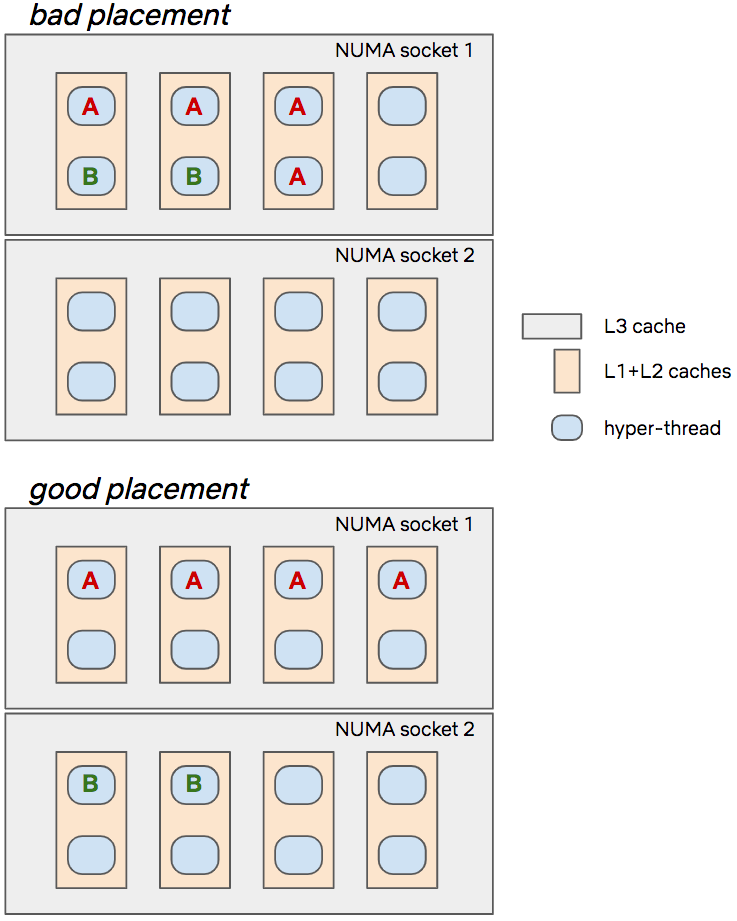

Random Scheduler Note
source link: https://kkc.github.io/2021/07/11/scheduler-note/
Go to the source link to view the article. You can view the picture content, updated content and better typesetting reading experience. If the link is broken, please click the button below to view the snapshot at that time.

Random Scheduler Note
Golang Scheduler
最近因為 golang 討論區的一篇文章,又簡單複習了下 golang scheduler,其實這個 scheduler 設計上面算是蠻簡單的,具體的內容其實很多文章都寫過了,而特點就是讓多個 goroutines 跑在 OS thread 上,是個 M:N 的分配,盡量減少了 OS thread 的建立,進而減少 OS thread 昂貴的 context switches 時間,runtime scheduler 則根據一些規則 (local, global runnable job & work stealing) 負責把 goroutines 分配給對應的 OS thread,並且在特定時機切換 core 的擁有權,讓 goroutines 們看似能夠平行運作。
不過我其實是知道不同的 goroutine schedule 到同一個 OS thread 上面,還有一個潛在的好處就是,不同 goroutine 間的共享變數,能夠善用 L1/L2 cache,而在現今的 NUMA 架構下的 CPU,這方面對於 scheduler 的效能還是有蠻大的影響,不過查了下其實在 2014 年 google 的 Dmitry Vyukov 就有在提 NUMA-aware scheduler for Go,不過一直沒有完成,也就是說現在的 scheduler 只是被動得到了一些好處,並不是完全考慮硬體架構的 scheduler。
NUMA-aware Scheduler
而輾轉又看到 Netflix 也有相關的 NUMA-aware scheduler 的文章,不過是針對不同的 heterogeneous workload 去設計,一般來說 Linux 上面的 CFS 只是幫我們很公平的分配 cpu 給不同的 process,剩下的都需要 application owner 自己去手動調整,像是 priority or cpu affinity 之類的設定,這篇文章則是在提了一個範例,如果 container A 是 cpu intensive,container B 是 latency-intensive,則應該把 container A 趕去不同的 NUMA socket,減少 cache thrashin 的機率。
For example if we predict that container A is going to become very CPU intensive soon, then maybe we should run it on a different NUMA socket than container B which is very latency-sensitive. This avoids thrashing caches too much for B and evens out the pressure on the L3 caches of the machine.
而底下這張圖很好的解釋了,該怎麼去 allocate A & B container 才是好的 resource 使用方式。

from https://netflixtechblog.com/predictive-cpu-isolation-of-containers-at-netflix-91f014d856c7
而 Netflix 更進一步的去想怎麼樣自動化這件事情,也提到 resource allocation 是個經典的數學問題。
Resource allocation problems can be efficiently solved through a branch of mathematics called combinatorial optimization, used for example for airline scheduling or logistics problems.
最後 formulate 成線性規劃的問題,也把相關的演算法實作在 cgroups 上面,並且 opensource titus-isolate 了出來。
其實 Netflix 這篇文的圖文解釋很棒,也告訴我們怎樣的標準來 schedule Numa-aware task 是好的,畢竟很多人都沒有用 data center 那麼大的機器,而有這些知識,去手動調整我們的程式可能也是不錯的解法。
- avoid spreading a container across multiple NUMA sockets (to avoid potentially slow cross-sockets memory accesses or page migrations)
- don’t use hyper-threads unless you need to (to reduce L1/L2 thrashing)
- try to even out pressure on the L3 caches (based on potential measurements of the container’s hardware usage)
另外是 scheduler 的演算法和論文很多,還是要看解決的問題和 workload 是什麼,找到評量的目標和 loss function,才能真的去設計一個演算法。
Recommend
About Joyk
Aggregate valuable and interesting links.
Joyk means Joy of geeK